#Soviet new year ornaments
Explore tagged Tumblr posts
Text
Small part of my collection :)


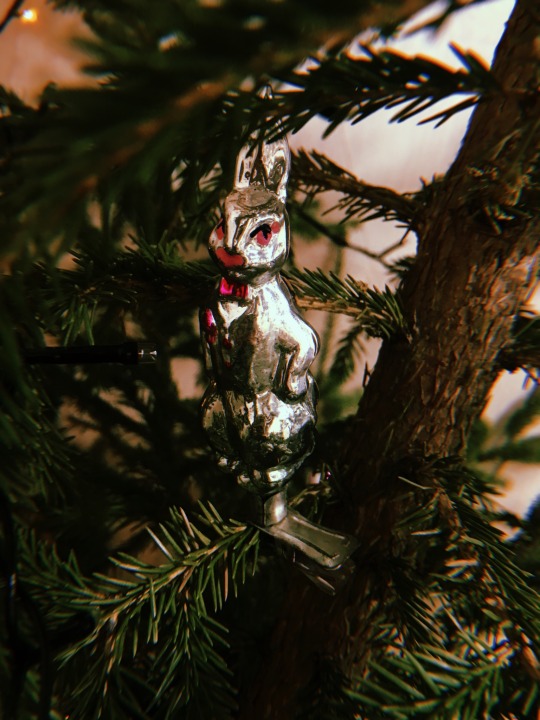


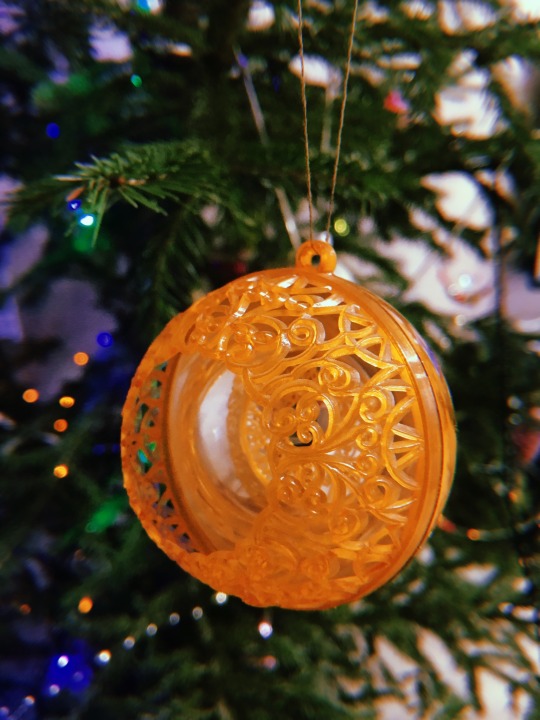
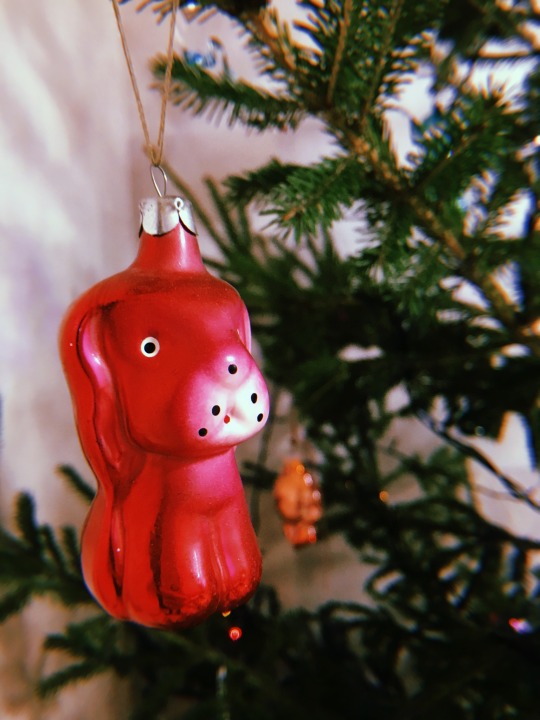

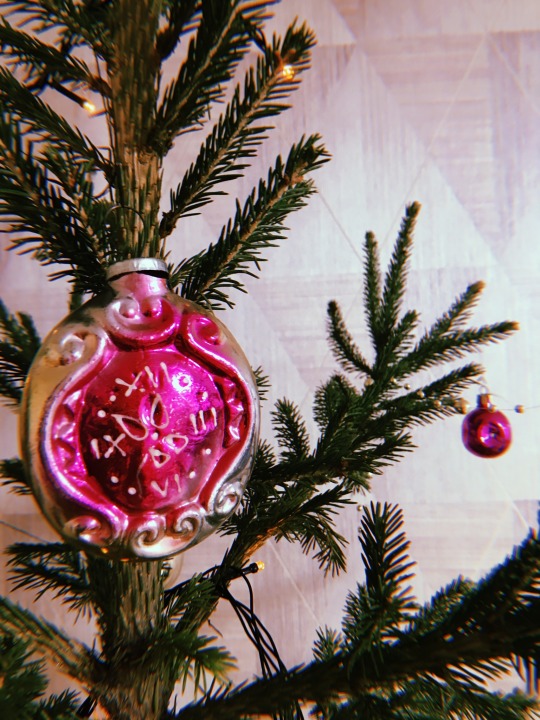

@sovietpostcards @sovietpostcards
#sovietstyle#Sovietnewyear#ornaments#новогодняя елка#новогодниеигрушки#дедмороз#советские ёлочные игрушки#Soviet new year ornaments#new year
181 notes
·
View notes
Photo
@sovietpostcards
I have a similar mask 😍 super old!


Soviet 1960s New Year masks and tree ornaments (via Moscow Museum)
271 notes
·
View notes
Text
Submitted via Google Form:
What would incentive a city to completely redesign their whole city and make all similar use buildings with the same layout and connect all the buildings together. What I mean by similar use is office buildings vs residental buildings vs public buildings. Of course individuals owning specific units/floors can do whatever contruction they want. I'm talking about something the size of Manhattan. Could they possibly do it in sections? Especially since people are living and working there. Start with new land taken from reclamation or the wilderness? Perhaps it would take 100 years from the first new building to the very last one? Then there's the problem of perhaps historical buildings - perhaps those might be exceptions that won't get connected? Or what happens if for whatever reason the project just stops half way. I mean 100 years is a whole long time. Governments that allowed it back then could totally have changed.
Utuabzu: You should look into Kowloon Walled City. While it no longer exists, and was vastly smaller, it was probably the nearest equivalent to what you want here. But something that should be obvious from even a brief skim of wikipedia is that Kowloon Walled City developed the way it did because of some specific circumstances. It was without any formal government and thus acted as a refuge for displaced people from China and various criminals and social outcasts from Hong Kong, and its physical area was firmly constrained, forcing any new construction to be inwards and upwards, rather than outwards. You should consider why your community is being built like this. Is their physical area constrained by geography or politics? Is there some cultural reason?
Another thing you should consider is the psychological and social impact that a monotonous urban environment will have on the people living in it. There's a reason everyone hates the repetitive grey concrete blocks that were built in postwar Eastern Europe and as public housing in much of the west. They lack any visual interest, and this has negative psychological effects on the people living in and around them, and the uniformity makes it difficult for people to form any sort of attachment to the space. Which is a major reason why these buildings tend to look so dingy now. Nobody gives enough of a damn to clean or maintain them.
Conversely, add a bit of visual interest via ornamentation and a more human scale, and people start to like the place, and are more likely to care for it. Look at the historic cores of older cities across the world, and the amount of effort and resources people are willing to expend to maintain them. People like pretty things and pretty places, especially ones that feel distinct. They help to form local identities - we are people from this place - which help to create a sense of community and shared responsibility for them.
Now, if you want a dingy dystopian megacity, look to big public housing projects from the 50s to about the 80s or 90s in the US and Western Europe, and cheaply built Soviet apartments, and sprinkle in some Kowloon for flavour. You can make a place pretty believably unpleasant by looking at real world examples. But if you want this to be a pleasant place, you need to consider the way the built environment is going to make people feel.
Feral: In addition Utuabzu’s examples, I would look to the Boulevards of Paris, which include construction across regime changes.
I’d also like to point out, if it’s not on your mind already for this world, but an official “state architecture” is heavily associated with fascism and other forms of totalitarianism. Back in 2020, there was a huge kerfuffle in the American architectural world when Trump signed an Executive Order limiting the styles of architecture federal buildings were allowed to be constructed in with for this very reason.
9 notes
·
View notes
Text

Soviet New Year tree ornament, 1980s.
11 notes
·
View notes
Text
Cultural Patrimony and the War in Ukraine
I have been looking into the repatriation of artworks like the Parthenon marbles, and Benin Bronzes. It has been eye opening to see how many artifacts have been stolen or looted from their countries of origin, especially by Britain and the U.S.
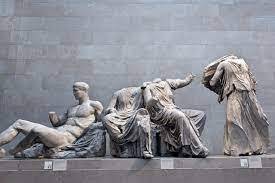
Earlier this month when I began writing this post it was going to be focused on a marauder-style looting of Scythian Gold from art museums in Melitopol and Mariupol, Ukraine by Russian forces in April of this year. But, just two weeks ago at the beginning of November there was yet another tremendous raiding at the Kherson Art Museum in Southern Ukraine. The Russians destroyed many businesses, churches, homes, and cultural sites in the raid where much of the loot was found as Museum staff and community members tried to preserve it. As aforementioned, this is not the first strike Soviet forces have made on Ukrainian Art and Cultural institutions, those who understood the cultural significance of the items tried to save them. The museum was home to hundreds of paintings dating back to the 17th Century. Shortly after the raid, Soviets withdrew from the Southern Ukrainian city of Kherson in retreat with vans full of thousands of priceless artifacts.


These stolen paintings and artifacts are a part of a larger, darker tactic to scrub Ukrainians, Belarusians, Poles, and other Eastern Europeans of their cultural heritage and independence. Art is only the tip of the iceberg unfortunately, this month's raids included the vandalism and removal of 200 year old holy remains from their resting place in one of the 250+ Orthodox and Christian churches destroyed since the war began. Not to mention the homes, businesses, technology, national monuments and written history that have been lost. This is Ethnic cleansing and it is a war crime, these pieces must be returned to Ukraine.

The Scythian gold is one of the more pressing issues of this Museum theft, though. We're talking about approximately 198 solid gold artifacts, jewelry, ornaments, weapons, armor, and sculptures dating back over 2300 years, stolen, and not because they were just stumbled upon either. Similarly to how the staff at the Kherson Museum tried to hide and preserve the artwork, the staff at the Melitopol Museum tried even harder. In a New York Times interview in April, Museum Director Leila Ibrahimova describes hiding the Scythian Gold in cardboard boxes in a cellar or basement at the first signs of Russian Militarization in Melitopol back in February. About a month later, Ibrahimova recounted being kidnapped from her home with a black bag on her head for hours of intense questioning by Russian forces. She did not give in and was released, promptly fleeing Melitopol for somewhere not under Russian control. It was another month after that when a different museum employee was put at gunpoint for the Scythian Gold, she did not lead them but they found the boxes anyway.
The next day, in Kyiv, the Mayor of Melitopol gave an enraged press announcement that Ukraine's Scythian gold was gone with the Russians and no one had its whereabouts any longer.

Scythian Gold describes a type of gold sculpture or artifact from the 7-3 Century BCE, made by Scythian or nomadic people in a geographic "band" across the Pontic-Caspian Steppe from around Romania, west through Siberia. This is one of the most sought-after collections of artwork by museums throughout history, known for its rich origins and cultural backgrounds. Scythian gold is also said to be the purest gold there is, and it has disambiguations in the context of alchemy, mythology, and religion as well. It has been reported by multiple sources, although not confirmed, that select pieces of Scythian gold that were stolen from the Melitopol Museum have hit the stolen art market online and underground for bidding. All I can say is it's a shame and I am feeling very sorry for those living in Ukraine and the generations of war, violence, natural disasters, and ethnic cleansing they have faced.
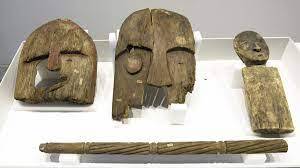
In that initial research into stolen ancient art I mentioned, I noticed that most of the articles and hot-button issues coming up were focusing on Western European countries (UK, Spain, France), stealing from prehistoric cultures around the world. It's interesting to me as a student who had weekly field trips to LOCAL (Northeastern U.S. ) art museums and saw plenty of ancient "tribal" art and cultural and religious artifacts from across the globe, that the U.S. apparently acquired all of it ethically. I digress, I just thought it was worth mentioning that a suspiciously small amount of info on stolen art in the Americas was available.
#art#art history#stolen art#stolen artifacts#ancient art#archeology#prehistoric#prehistoric art#ukraine#russia#ukraine war#looting#south ukraine#britain#british museum#fascisim#ethnic cleansing#cultural erasure#Scythian gold#middle east art#kherson#kherson retreat#kherson museum#melitopol
2 notes
·
View notes
Text
The 7 best museums to visit in Russia

Russia has some of the most intriguing museums in the world, exhibiting its rich history, culture, and artwork. From historical relics to contemporary works of art, these museums provide tourists with an insight into Russia's rich past and achievements. Everyone may explore and learn something new, regardless of their interests in science, art, or history.
There is a vast array of interests and attractions at Russia's top museums. Every museum provides a different and immersive experience, from the famous State Hermitage Museum in Saint Petersburg to the ancient State Historical Museum in Moscow. Explore the nation's turbulent past, take in breathtaking artwork, or uncover cutting-edge scientific advancements.
These museums offer an intriguing view into Russia's cultural identity and accomplishments with their outstanding collections, breathtaking architecture, and educational exhibitions. Russia's museums provide visitors of all ages with an engaging and unforgettable experience, regardless of their interests in art, history, or just learning more about the world they live in. Thus, prepare to travel through Russia's rich cultural legacy by visiting its top museums and packing your baggage.
Here are some of the 7 best museums to visit in Russia.
1. The Museum of the State Hermitage: One of the biggest and most well-known museums in the world is the State Hermitage Museum, which is situated in Saint Petersburg. It is home to an extensive collection of objects and artwork that spans thousands of years, including masterpieces from modern times and ancient civilizations. The lavish halls of the museum, which feature pieces by well-known painters including Michelangelo, Rembrandt, and Leonardo da Vinci, are open for exploration by guests. The hermitage, whose main complex is housed in the old Winter Palace, is likewise renowned for its magnificent architecture.
2. The Tretyakov Gallery of the State: The leading museum of fine art in Russia is the State Tretyakov Gallery, which is situated in Moscow. It showcases the rich cultural legacy of Russia with a collection of paintings, sculptures, and icons from the 11th to the 20th centuries. Famous pieces by Russian artists including Ivan Aivazovsky, Mikhail Vrubel, and Ivan Shishkin are among the highlights. The collection of the museum encompasses a wide range of creative trends, including impressionism, realism, and the avant-garde, offering visitors a thorough understanding of Russian art history.
3. The Museum of State History: Russia's rich history and legacy are preserved in the State Historical Museum, which is located in the city's famous Red Square in Moscow. The extensive collection of the museum consists of artifacts, records, and works of art from the ancient era to the present. To gain insight into the intriguing past of the nation, visitors may peruse exhibitions on ancient civilizations, medieval Russia, the Romanov dynasty, and the Soviet era. The museum is a notable sight in Moscow's skyline because of its eye-catching red brick front and elaborate interiors.
4. The Fortress of Peter and Paul: One of Saint Petersburg's most recognizable and historic sites is the Peter and Paul Fortress. Originally constructed in the 18th century as a defensive castle, it today has a number of museums and other cultural attractions. The ancient grounds of the castle are open to visitors, who may see the Peter and Paul Cathedral, the resting place of several Russian tsars. In addition, the castle has museums devoted to political prisoners, the Russian navy, and Saint Petersburg history, providing visitors with a glimpse into the city's colourful past.
5. The Fine Arts State Museum of Pushkin: Europe's finest art is well represented in the collection of the Moscow-based Pushkin State Museum of Fine Arts. Along with Russian icons and ornamental arts, it has artwork from a variety of creative movements, such as Impressionism, Baroque, and Renaissance. Masterpieces by renowned painters including Picasso, Rembrandt, Van Gogh, and Botticelli are on display for visitors to appreciate. Art lovers and cultural tourists alike should not miss the museum's remarkable architecture and varied collection.
6. The Museum of Russia: The biggest repository of fine art from Russia is the Russian Museum, which is located in Saint Petersburg. It has an extensive collection of ornamental arts, paintings, and sculptures from the tenth to the twenty-first century. Along with pieces by well-known Russian painters including Ilya Repin, Ivan Kramskoi, and Kazimir Malevich, visitors may explore exhibitions on Russian history, culture, and folklore. The Mikhailovsky Palace and Marble Palace, two of the museum's ancient structures, offer a breathtaking setting for its vast exhibits.
7. The Cosmonautics State Museum: The State Museum of Cosmonautics honours Russia's space exploration accomplishments and is situated in Moscow. It showcases relics, models, and interactive displays connected to cosmonautics in its exhibitions on the history of spaceflight. Important turning points in space exploration history are covered for visitors, such as Yuri Gagarin's first human spaceflight and the Apollo-Soyuz Test Project. A unique look into the history of space flight is offered by the museum's collection of spacecraft, which includes models of satellites, rockets, and space capsules.
Conclusion
A fascinating tour through Russia's rich history, art, and culture may be had by visiting its top museums. These museums provide insightful looks into Russia's rich past, from the opulence of the State Hermitage Museum to the educational displays of the State Historical Museum. For tourists who want to see Russia's museums, getting a Russia visa from Delhi is a simple procedure that makes for a smooth trip. Visitors may fully immerse themselves in the fascinating world of Russian science, art, and history if they have the required documentation.
Russia's museums have something to offer everyone, whether they are appreciating famous works of art, exploring historical artifacts, or marvelling at scientific feats. For visitors of all origins and interests, these cultural institutions offer a fascinating and rewarding experience with their amazing collections, educational displays, and breathtaking architecture. Thus, be sure to include visits to Russia's top museums in your trip schedule, whether you're an art fan, a history buff, or just interested in learning more about the world. These museums provide an incredible tour into the core of Russia's cultural past with their abundance of information and cultural artifacts.
#Russia Visa From Delhi#Russia Visit Visa From Delhi#Russia Tourist Visa From Delhi#Russia Visit Visa Processing Time From Delhi#Russia Tourist Visa Cost From Delhi#Russia Tourist Visa Price From Delhi#Russia Visa Appointment In Delhi
1 note
·
View note
Text

Soviet New Year tree ornament, 1980s.
1 note
·
View note
Text
Episode 2
I loved the song Zolushka (Cinderella) when I was young, and still do. https://www.youtube.com/watch?v=3ToJwWgbHGc The first verse goes something like this:
Believe it or not, last night I dreamed that a prince came for me, riding a silver stallion. And we were greeted by dancers, a drummer, and a trumpeter, forty-eight conductors, and one grey-haired violinist.
While this vision of the king's ball doesn't exactly mesh with the Disney version, it enchanted to me as a young girl. My memories of it are all tied up with the period leading up to New Year's Eve. The Soviet Union, having outlawed all religion and religious practices, gleefully transferred all Christmas traditions to New Year's Eve. The tree, the presents, and Father Frost (Santa) were part of my childhood every December.
As Soviet citizens, our being Jewish notwithstanding, my parents bought a live tree, which we decorated with beautiful, fragile, glass ornaments

and topped with an equally lovely and fragile glass topper.
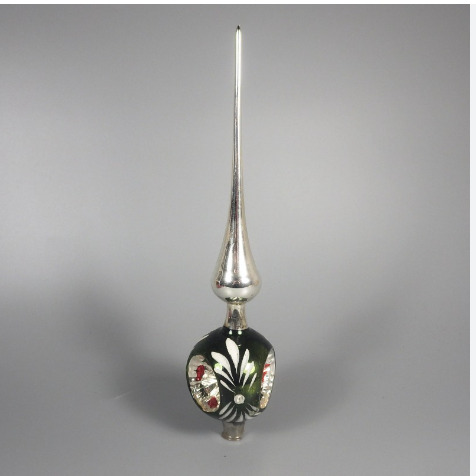
I loved, loved, loved Leningrad in December. It was magic, the way the city transformed from autumn's grey, cold, rainy dreariness to winter's frosted, glittering, jewel box! Leningrad was alive to me in December. Lights everywhere! Store windows displaying things in pretty packaging (never mind that the stores were mostly empty inside)! Oranges wrapped in shiny foil and candy in gorgeous boxes!
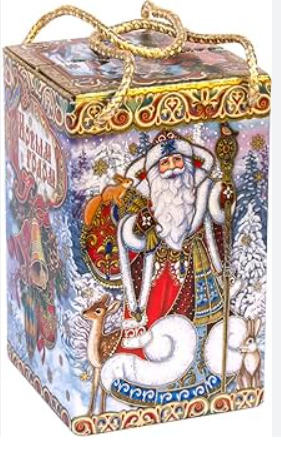
Leningrad's elegant bridges and buildings sparkled under the star-filled sky! Magic, I tell you.
I had no difficulty, as a child, believing in Grandfather Frost, Russia's version of Santa. He always appeared sometime during night of December 31, with his bag of gifts. No chimney climbing for Grandfather Frost, either. Leningrad's residents didn't have chimneys anyway, living as we all did, in apartments. Grandfather Frost simply appeared, though you could never see him, delivered a present for each person in the house, and disappeared. If you slept through it, you'd find your gift the morning of January 1, but if you were very lucky and allowed to stay up late, you might just hear him, and you might just get your gift earlier!
This actually happened to me one year. My parents were hosting a small gathering for friends, when suddenly there was a loud "thump" and the lights went out. When the lights came back on a few minutes later, there were presents under the tree! Of course, everyone knew exactly what had happened. Grandfather Frost had been there! I was beside myself at the idea that I had actually been awake to "witness" his visit. I have absolutely no recollection of the actual gift bestowed on my by Grandfather Frost that New Year's Eve. That wasn't the point at all.
Grandfather Frost must have really liked me. Not only did he show up the night of that party, but he actually walked right up to our apartment building one year with his daughter, the Snow Maiden. I was playing outside with a friend and saw him knocking on the door. I didn't know why he was there, and I didn't think to ask. Many years later, I found a photo of that incident. Grandfather Frost looked suspiciously like my dad in a fur-trimmed suit and a white beard, but that doesn't spoil the magic of that memory for me.
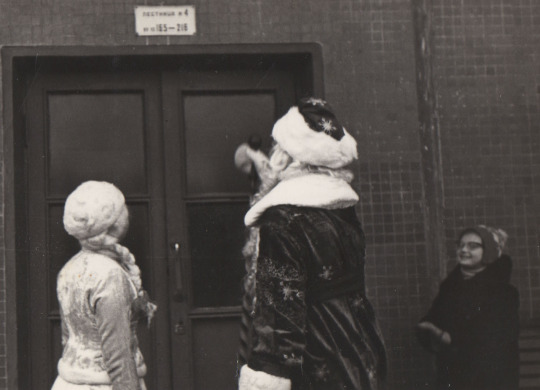
0 notes
Photo









Russians Looted Priceless Artifacts From Museums in Mariupol and Melitopol
The heist started when a mysterious man in a white lab coat showed up at the museum.
A squad of Russian soldiers stood behind him, with guns, watching eagerly.
Using long tweezers and special gloves, the man in the white coat carefully extracted scores of special gold artifacts more than 2,300 years old from cardboard boxes in the cellar of a museum in Melitopol, a southern town in Russian-occupied territory, Ukrainian officials said. The gold items were from the Scythian empire and dated back to the fourth century B.C.
Then the mysterious expert, the Russian soldiers and the gold disappeared.
“The orcs have taken hold of our Scythian gold,” declared Melitopol’s mayor, Ivan Fyodorov, using a derogatory term many Ukrainians reserve for Russian soldiers. “This is one of the largest and most expensive collections in Ukraine, and today we don’t know where they took it.”
This was hardly the first attack on Ukrainian culture since the war began.
In Mariupol, the town that has been hammered for weeks by Russian forces, officials said that Russian agents broke into an art museum and stole masterpiece paintings, a famous sculpture and several highly valued Christian icons.
Across Ukraine, officials said, dozens of Orthodox churches, national monuments and cultural heritage sites have been destroyed. In one town near Kyiv, Borodianka, Russian soldiers shot the bust of a famous Ukrainian poet in the head.
On Saturday, Ukrainian officials said that more than 250 cultural institutions had been damaged or destroyed.
But perhaps no cultural heist has been as brazen as what unfolded in Melitopol just a few days ago.
According to Leila Ibrahimova, the director of the Melitopol Museum of Local History, the trouble started in late February, when Russian forces shelled the airport and took over the city. Soldiers went on a rampage, smashing into supermarkets, stores and homes.
Most of the city’s residents hid inside their houses. But a few museum workers, including Ms. Ibrahimova, made their way back to the museum.
It is an elegant, three-story, stone building in the old part of town, home to 50,000 exhibits, from Soviet-era medals to old battle axes. But its prized collection was a set of rare gold ornaments from the Scythians, a nomadic people that founded a rich, powerful empire, centered in the Crimean Peninsula, that endured from around the eighth century B.C. to the second century A.D.
It was the Scythian gold that Ms. Ibrahimova was most worried about.
She and other staff members secretly hid it and some other historic artifacts in cardboard boxes, stashing the boxes in a dank cellar where they didn’t think anyone would find it.
“We knew that any second someone could come into the museum with a weapon,” she said. So they worked fast, she said, because “the collection is priceless.”
In mid-March, Ms. Ibrahimova said Russian troops burst into her house with assault rifles, threw a black hood over her head and kidnapped her. After several hours of intense questioning, they let her go. Two weeks later she left Melitopol for an area not under Russian control.
But on Wednesday, she received a call from a caretaker at the museum. The caretaker said Russian soldiers, along with intelligence officers and a Russian-speaking man in a white lab coat, had come to her house in the morning and ordered her, at gunpoint, to go with them to the museum.
They commanded her to take them to the Scythian gold.
The caretaker refused, Ms. Ibrahimova said. But the man in the white coat found the boxes anyway with the help of a Ukrainian, Evgeny Gorlachev, who was appointed by the Russian military as the museum’s new director, she said. A Russian crew filmed part of the robbery.
“We hid everything but somehow they found it,” she said.
What was stolen: at least 198 gold items, including ornaments in the form of flowers; gold plates; rare old weapons; 300-year-old silver coins; and special medals. She said many of the gold artifacts had been given to the Scythians by the Greeks.
In an interview on Russian television, Mr. Gorlachev said the gold artifacts “are of great cultural value for the entire former Soviet Union” and that the previous administrators of the museum “spent a lot of effort and energy” to hide them.
“For what purpose, no one knows,” he said. “But thanks to these people and the operational work carried out, residents of the city of Melitopol — and not only Melitopol — will be able to observe again a large collection of Scythian gold.” He did not say when or where the artifacts would be displayed.
Ms. Ibrahimova, who spoke by phone, sounded despondent as she spoke about the Russian invaders.
“Maybe culture is the enemy for them,” she said. “They said that Ukraine has no state, no history. They just want to destroy our country. I hope they will not succeed.”
Scythian gold has enormous symbolic value in Ukraine. Other collections of the artifacts had been stored in vaults in the capital, Kyiv, before the war broke out. But Ms. Ibrahimova said events unfolded too fast for her museum to spirit out their collection.
For years now, Ukraine has been locked in a complicated dispute with Russia over collections of Scythian gold that several museums in Crimea had lent to a museum in Amsterdam. After Russia seized Crimea in 2014, Ukraine pleaded with the Amsterdam museum not to return the gold. Russia demanded the museum do just that. A court has ruled in Ukraine’s favor and the gold remains in Amsterdam.
But historians said the looting of the artifacts in Melitopol is an even more egregious attempt to appropriate, and perhaps destroy, Ukraine’s cultural heritage.
“The Russians are making a war without rules,” said Oleksandr Symonenko, a fellow of Ukraine’s Archaeology Institute and a Scythian specialist. “This is not a war. It is destroying our life, our nature, our culture, our industry, everything. This is a crime.”
The caretaker who refused to help the Russians was released on Wednesday after the gold was stolen. But on Friday she was taken away from her house at gunpoint again, Ms. Ibrahimova said, shortly after the mayor, who is also in exile, announced the theft.
She has not been heard from since.
By Jeffrey Gettleman and Oleksandr Chubko.
#2022 russian invasion of ukraine#2022 russia-ukraine news#Russians Looted Priceless Artifacts From Museums in Mariupol and Melitopol#the Scythian empire#ukraine#russia#art#artist#art work#art news#stolen art#history#history news#ancient history#ancient culture#ancient civilizations#Scythian gold#treasure#war#world at war#war crimes#looting#steaking#stolen#sad
214 notes
·
View notes
Photo
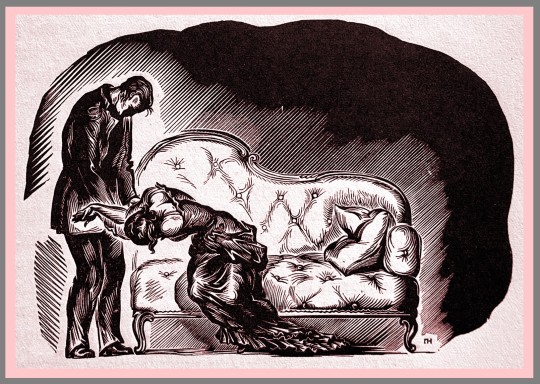
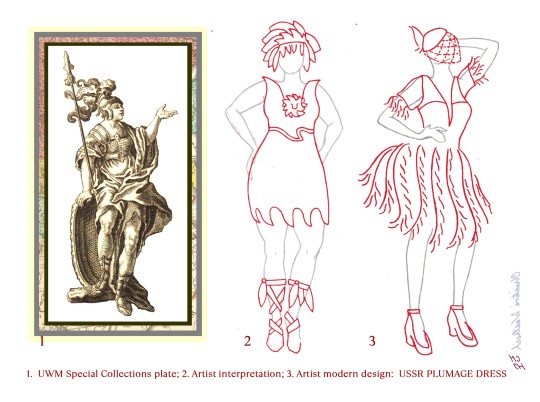
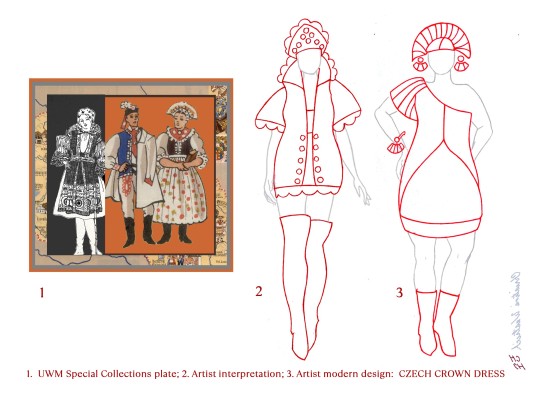
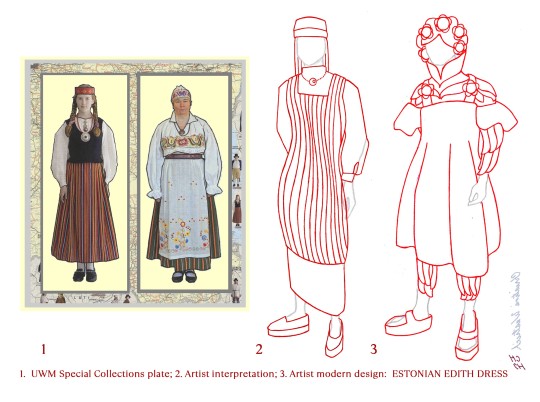
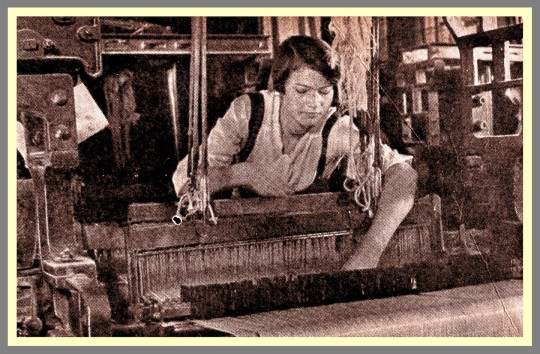
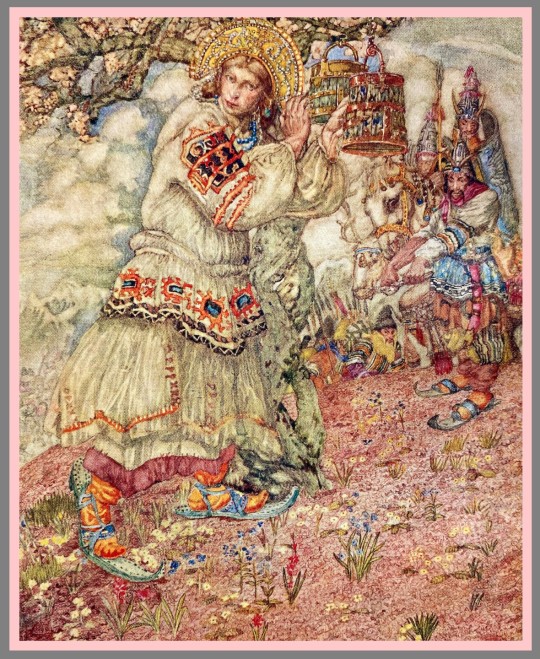


Fashion Friday: The Power of Plumage
The dissolution of the Soviet Union in 1991 resulted in the creation of fifteen nation-states including Ukraine and Estonia, while 1993 saw the end of communist rule in Czechoslovakia, becoming the Czech Republic and Slovakia. These nations are featured here in my second-to-last fashion plate post with costumes honoring easier days of traditional ethnic dress.
Leo Tolstoy could be argued as the conscience of Russian peasants by his fictional writing in the classic Anna Karenina. Tolstoy was in fact a nobleman and landowner yet he adorned himself in smocks and meager dress, fashioning humility as he wrote of earthly indulgences and subtle sermons on the wickedness of the human condition.
The dress of laborers is also honored in a 1936 Soviet Union publication on a revered textile worker in Miss USSR where a young woman's 10-hour days and record-breaking statistics on factory looms are lauded as joyful. Her uniform is a black silk blouse and skirt and her profile is documented as "slim" and "little."
Yet, as with the earliest civilizations there is a place for costume, for adornment that celebrates more than the work of our hands or size of our bodies, whether a farmer's, a writer's, or a weaver's; we yearn for the occasion allowing ornamentation that arouses our senses and inflames our imaginations.
My first fashion plate is titled the USSR Plume Dress, perhaps interpreted by some as a peacock's egoism; the second plate may be favored by fan-followers of Egon Schiele, while the last crowns brawn and might.
Here is a listing of sources from the UWM Special Collections and the UWM American Geographical Society Library that I have augmented with digital color and outline to emphasize particular details of my inspiration:
1, 8) Wood-engravings by Nikolas Piskariov as featured in Leo Tolstoy's Anna Karenina; published in the USSR in 1933 and printed by the Limited Editions Club, respectively titled Anna's Fall and Head-Piece to Part the Fifth.
2-4) My contemporary designs of the USSR Plume Dress, Estonian Edith Dress, and Czech Crown Dress based on maps from the collection of the UWM American Geographical Society Library that show iconic costumes, respectively titled Russian Empire 1757, published in Augsburg, GE by Augustae Vindel in 1757; Folklore Map of Czechoslovakia, published in Czechoslovakia by the Ministerstvo Informaci in 1948; Parishes of Estonia 2010, published by the AS Regio in 2010.
3) Black and white drawing of Czechoslovakian dress by Belle Northrup in A Short Description of Historic Fashion published by Columbia University's Teachers College in 1925.
5) Photograph of Dusya Vinogradovo a 21-year old woman dubbed Miss USSR: The Story of a Girl Stakhanovite, the Soviet Union's leader in weaving production and noted to be every young person's friend as she was "free and happy"; published in New York by International Publishers in 1936.
6, 7) Illustrations by Noel L. Nisbet from the collection of Russian Cossack Fairy Tales and Folk Tales, published in London by George G. Harrap & CO in 1916, respectively titled They Came to the Place Where He Had Left Her and His Wife Caressed and Wheedled Him.
View my other posts on historical fashion research in Special Collections.
View more Fashion Friday posts.
—Christine Westrich, MFA Graduate Student in Intermedia Arts
#Fashion Friday#graduate research#Christine Westrich#fashion plates#costume design#fashion design#Eastern Europe#leo tolstoy#Anna Karenina#Russian costumes#Czechoslovakian costumes#Estonian costumes#A Short Description of Historic Fashion#Miss USSR#Cossack Fairy Tales and Folk Tales
55 notes
·
View notes
Text
Less is More| Keep subtracting until it falls apart.
Text by Makoto. Li
The philosophy of minimalism may seem simple, but since Bauhaus, it has been the challenge of countless designers and artists to find the balance before it collapses. The Minimal Art movement, which emerged in the US in the 1960s, abandoned even the notion of ornamentation and curves in the first 50 years of the 20th century, while the 1990s saw a wave of minimalist fashion, with basic black and white pieces, taking the hassle out of matching. Let's take a look below.

Composition II in Red, Blue, and Yellow,1929.
From Picasso and Georges Braque, who turned the depth of field into a flat surface, to Piet Cornelies Mondrian and the Dutch stylistic movement (De Stijl, also known as Neoplasticism), who reduced design to three primary colours, black, white and grey and vertical horizontality, to Suprematism, who used basic geometric shapes to convey the artist's idea of light, simplicity has been the beauty of the art.

Christie's Richard Hamilton (1922-2011) | Putting on de Stijl.
But no matter how simplified the forms are, artworks of the past and present have more or less 'ideas to be conveyed' or 'hidden metaphors'. What makes the minimalist art of the 1960s different is the blunt statement of the artist - "we have nothing to say"- and not only the surface decoration but also the artist's emotions and even the traces of his creation are entirely stripped away.
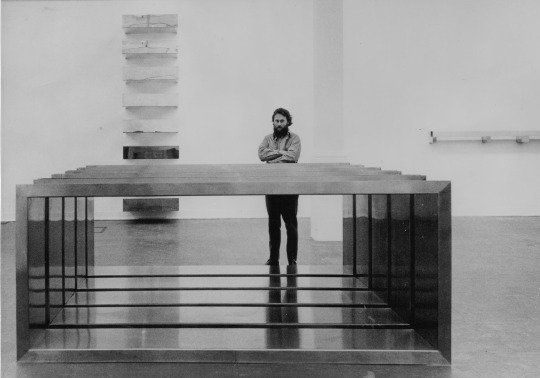
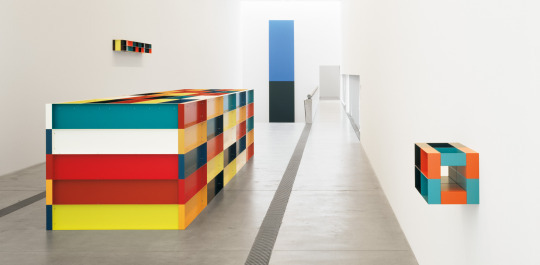
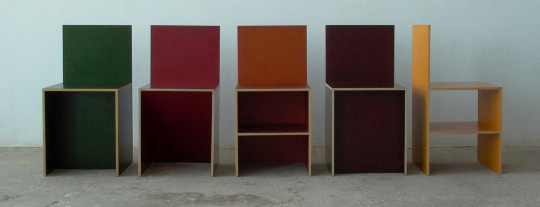
"There isn't anything to look at", said Donald Judd, the icon of minimalism - a statement that says that minimalism does not rely on illusory concepts but only appreciates the aesthetics of material purity.


Culture Trip History of a Painting: 'The Black Square' by Malevich.
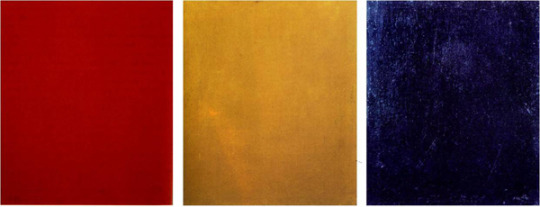
'Pure Red Colour, Pure Yellow Colour, Pure Blue Colour' (1921) by Alexander Rodchenko.
Based on Marxist materialism, Constructivist artists such as Vladimir Tatlin and Alexander Rodchenko were engineers of design structures, abandoning all nebulous concepts of art to make art a servant of society. They wanted to make art a public servant of humanity. However, the Cold War between the US and the Soviet Union brought artistic exchanges between the two countries to a standstill, so New York's 1960s Minimalism reflected advanced material civilisation and manufacturing technology.

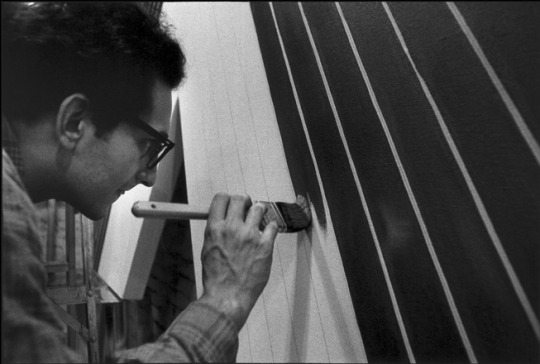
Frank Stella. The Marriage of Reason and Squalor, II. 1959.
In 1959, painter Frank Stella pioneered the concept of 'painters as workers and engineers' in the United States; using a paintbrush and glazes, the artist regularly lined the canvas with black and white lines. He decided to abandon the national imagery and work with simple lines.

MoMA Frank Stella. Arbeit Macht Frei from Black Series I. 1967.

MoMA Frank Stella. Die Fahne Hoch!
Although the paintings still seem slightly inadequate in the light of later minimalist art - the irregular shaking of the artist's fingers still reveals signs of artificiality, and the titles, such as the fascist slogan 'Die Fahne Hoch' or 'Arbeit Macht Frei', are inevitably too rich in connotation - the hard, cold visual style is a far cry from the previous Abstract Expressionism, led by the artist Jackson Pollock, who had been spilling paint with abandon. However, the rugged, cold visual style was a far cry from the abstract expressionism of Jackson Pollock, a painter. He had previously been known to spill paint with abandon and attracted the attention of the press and the art world. Later, Frank Stella turned to aluminium and copper bars as a medium to give the images a more industrial feel. In the 1970s, he introduced a series of 'Shaped Canvas', which twisted the canvas out of the two-dimensional world and reminded the viewer that 'a blank canvas is also a tangible entity'.

Donald Judd. Untitled. 1973.

Donald Judd. Untitled. 1986.
Donald Judd, a leading minimalist, first brought minimalist art into the three-dimensional realm in the early 1960s. Having started out as an expressionist painter, Donald Judd soon grew tired of the 'false' illusion of three dimensions on a flat surface; after a brief experiment with relief, he turned to industrial materials - aluminium, steel, polymer sheets and Plexiglas - to create basic geometric shapes, arranged at regular intervals to emphasise a logical, rational quality. In the mid-1960s, Donald Judd began to commission professional factories to execute his works, leaving himself to plan and design, erasing any trace of the artist's creativity.
Although the works are primarily three-dimensional, Donald Judd does not regard them as 'sculptures' but rather as 'specific objects', which are not sculpted but finished by standard industrial procedures - moulding, cutting, welding, polishing, etc. Donald Judd also believes that work must encompass the space around it and has said: 'Just as the length of a metre has a benchmark of platinum, smelting and casting, so modern art must be a model for a specific time and place. The size of a metre has a bar in platinum and smithing, so contemporary art must be a model for a particular place and time.
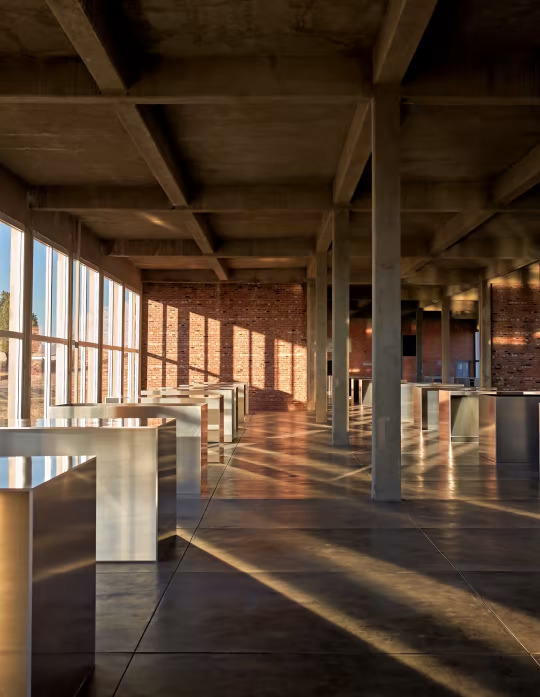



To implement his theories, he bought a five-storey flat in 1968 so that his work could interact with the environment in a fixed location, setting the stage for the subsequent boom in Installation Art and Site Specific Art. Judd bought 340 acres of land in the desert of Marfa, Texas, and turned a disused US Army bunker into a studio and exhibition space, which he named the Chitani Foundation. Since then, Donald Judd has purchased over 60,000 acres of wilderness around Marfa, inviting minimalist artists to work with him and leaving behind 15 concrete works and over 100 aluminium pieces.

Dan Flavin Art Institute, Bridgehampton, NY.
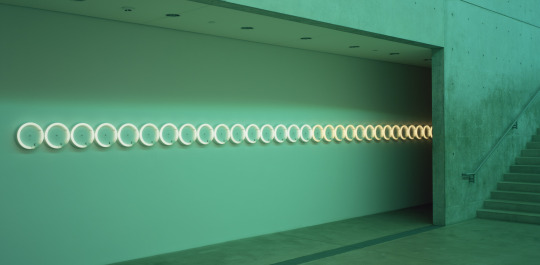

Dan Flavin: Constructed Light.
In the 1960s, artists' interpretations of 'minimalism' became increasingly sophisticated, with even the material itself becoming the object of diminution. For example, Dan Flavin's 1963 masterpiece The Diagonal, with its fluorescent tubes hung at a 45-degree angle, was the first to bring art into the realm of light; later, in the Monument for V. Tatlin series, which pays homage to the masters of Constructivism with its architectural arrangement, and in the Alternating series, which experiments with different colour combinations of light, the main focus is always on light and light. In the subsequent Monument for V. Tatlin series, which pays homage to the masters of Constructivism with its architectural arrangement, and the Alternating series, which experiments with different colour combinations of light, the main focus is always on the interaction between light and the exhibition space, and the fluorescent tubes themselves are no longer critical.
The increasing simplification of forms soon made minimal art contradictory, and not only did the leading art critics of the time, Clement Greenberg and Barbara Rose (Rose married Frank Stella in 1961 and they divorced in 1969), write numerous articles analysing minimal art, but Donald Judd often published essays alongside his work This has transformed Minimal Art from a 'non-conceptual' art form to one that is surprisingly rich in concepts.
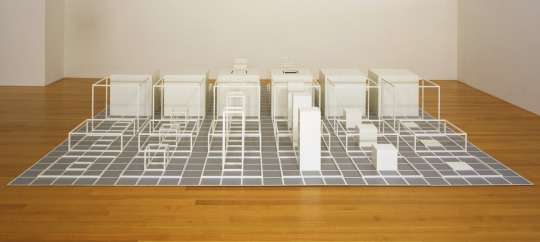
Sol LeWitt. Serial Project, I (ABCD). 1966.
To resolve this awkward situation, the artist Sol LeWitt, known for his ever-expanding matrix structures, proposed an answer to this unresolved problem in 1966 with his 'Sequence Project One', a 'Conceptual Art'. Abandoning the physical, Sol LeWitt reduced art to a series of instructions. He stated: "When the artist presents art in abstract form, all the planning and decisions are made beforehand, the actual production is optional, and the idea becomes the art-making machine. The subject and the client are switched, and the material becomes the object of simplification.

'Untitled', Robert Morris, 1967–8.
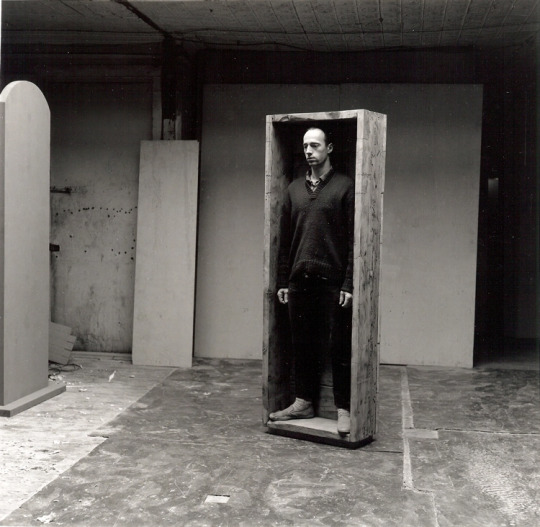
Robert Morris with Box for Standing, 1961.
In Box with the Sound of Its Own Making (1961), a wooden box was filled with a tape recorder that recorded the sound of sanding and tapping, allowing the viewer to experience the process of making the artwork at the same time while in the 1966-67 Felt series, Robert Morris used the soft drape of fabric to make the minimal less cold and rigid.

Primary Structure,1966.
From the mid-1960s onwards, Minimal Art became a niche avant-garde art and a sought-after object in significant galleries. After the 1966 'Primary Structure' exhibition, the Guggenheim Museum of Art and the Whitney Museum in New York staged minimalist art productions and invited artists to curate solo exhibitions. Although there are still a few scattered critics who are critical of Minimalism's 'anaemic' visual sensibility - Dan Flavin's fluorescent lights were once derided as 'the same as a shop window' - Minimalism has left an indelible mark on the history of art and design.

In fashion, minimalism didn't really take root until the 90s. From the Calvinists' all-black robes of the 16th century to the Dutch men's all-black fashion of the 17th century, to Dandy's ornate embroidery on tailoring in the 19th century, to the basic geometric designs of Pierre Cardin in the 1960s and 1970s, to the simple lines of André Courrèges and Yves Saint Laurent. The simplicity of the lines of André Courrèges and Yves Saint Laurent, if not a political rejection of courtly excesses, then a fanciful vision of a future sci-fi world.
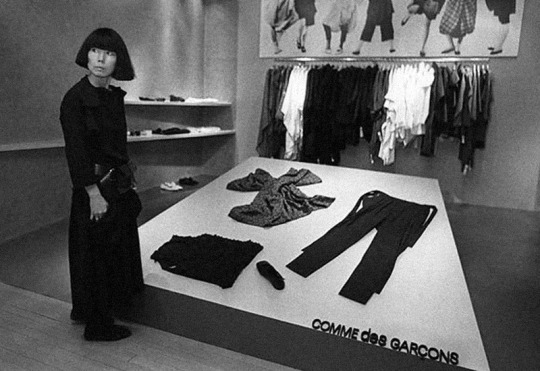

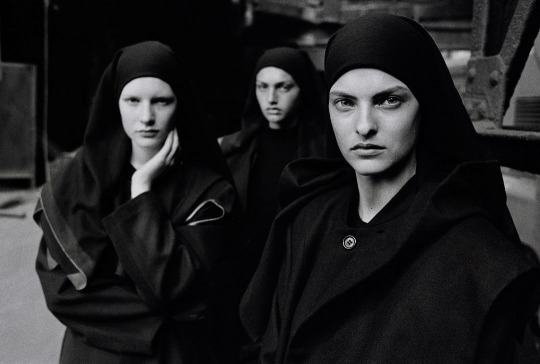
The always iconic image of Linda Evangelista, Michaela Bercu and Kirsten Owen for COMME des GARÇONS. Photographed by Peter Lindbergh in 1988.
Yohji Yamamoto and Comme des Garçons, who invaded Paris in the 1980s, and Maison Martin Margiela, who deconstructed and stripped away the forms of clothing vocabulary in the 1990s, were similar to the minimalist manifesto of de-conceptualisation. Still, the meticulous attention to detail made the clothes visually different from the rigid coldness of minimalist art.
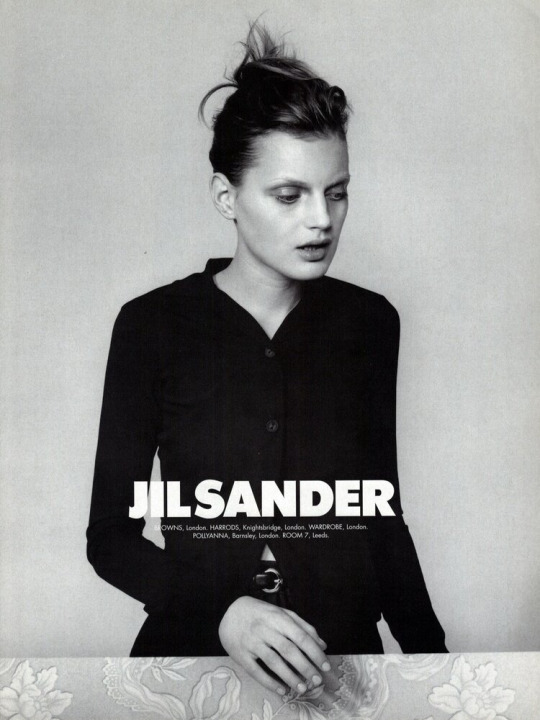
Guinevere van Seenus was photographed by Craig McDean for Jil Sander SS96 campaign.
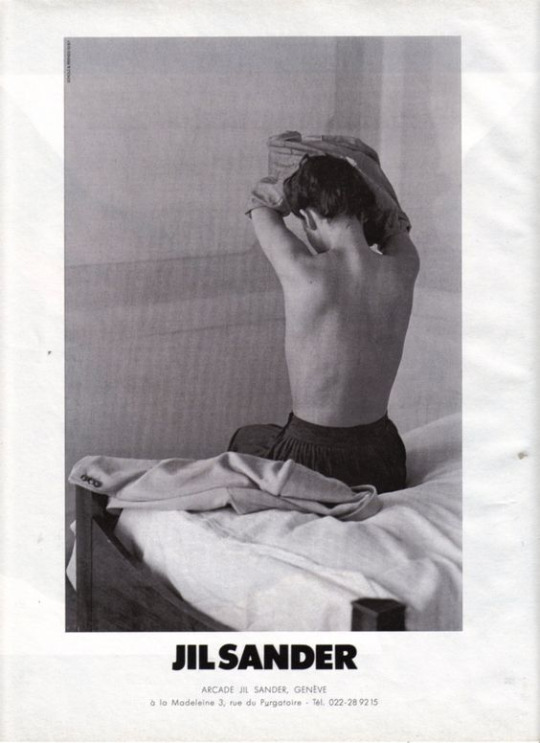

Jil Sander SS 1989.

Kirsten Owen for Jil Sander, photographed by Jean Francois Lepage, Fall/Winter 1990.

Jil Sander 1993 FW.
The '90s saw the 'anti-fashion' movement, with the exaggerated silhouettes and elaborate accessories of the '80s out of the picture, replaced by simple pieces that returned to the garment itself, with as few cut lines as possible and a black-and-white palette that made the garment work for the wearer, rather than making the fashion suffer. Jil Sander, known as the 'Queen of Minimalism', was founded in 1968, but it was only then that the brand gained widespread attention in the fashion world. By pairing a perfectly tailored trouser suit with a slim, tailored blazer, Jil Sander allows women to retain the confidence and dignity of a power suit while cutting out the padded shoulders, tones and embellishments to reinvent the working woman. Designed from the perspective of both the garment and the wearer, Jil Sander's garments required little effort to match and were known at the time as 'onions', meaning that each layer was quite similar; the designer's almost paranoid demand for fabrics also revealed the minimalist's fervent belief in materiality itself.

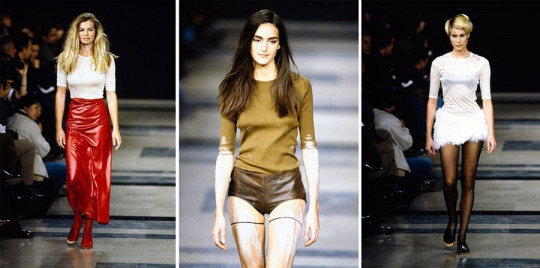
The complex, cold, minimalist aesthetic seems to have been born in the German-Austrian blood. Growing up in not-so-fashionable Vienna, Helmut Lang has been pushing the boundaries of simplicity since its first show in Paris in 1986. Anna Wintour recalled the first Helmut Lang show she saw: "I was like, 'This is not the spirit of the 80s! But then the economic bubble burst a few years later, and it became clear that Helmut Lang was already on the prowl.
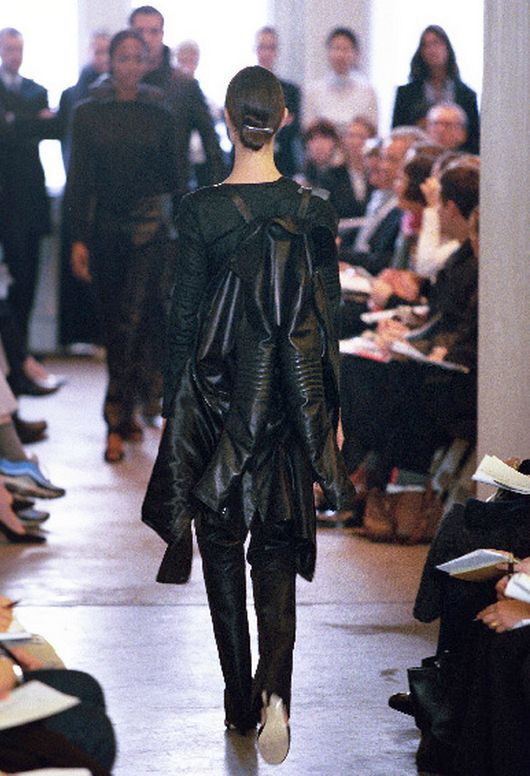
Helmut Lang 1999 FW.

Helmut lang autumn/winter 1999, backstage, by Juergen Teller.
Ahead of the 90s trend for office casual, Helmut Lang removed the symbols that separated formal and informal wear, creating a black and white fashion that was unconstrained by the occasion. "We were more than minimalist," said Michèle Montagne, who was in charge of Helmut Lang's PR at the time. "It was like a simplification contest; the fabrics weren't flashy, the silhouettes were stiff and rigid, the colours were minimal, and even the lines were the same for men and women. Helmut Lang, which always shows both men's and women's clothes, keeps the sound and light as simple as possible and calls its shows 'Séance de Travail': "Unlike Mugler or Montana, whose clothes are made for the stage, our clothes have nothing to do with the stage, they're just for wearing". says the designer.
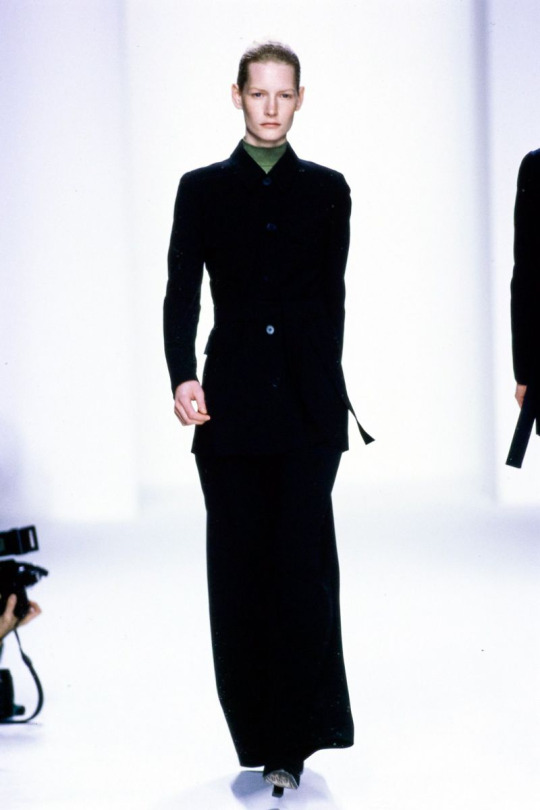
Calvin Klein 1996 FW.

Calvin Klein 1996 SS.
Calvin Klein, the embodiment of minimalist fashion in the 90s, returned to simplicity from the perspective of American business, which was also an unexpected fit with minimalist art. From a practical and marketable point of view, Calvin Klein's items in the 90s were reduced to one-piece dresses without seams, basic suits, white shirts of different lengths, knitted vests and pullovers, etc. This was in line with the 90s consumer mentality of sport, leisure and comfort, eliminating the hassle of dressing up and down and emphasising the modern spirit of practicality. Calvin Klein's penchant for simplicity was not limited to clothing, and in 1995 the designer hired British minimalist architect John Pawson to design the company's new headquarters and shop.

Céline 2017 SS.
The decorative elements that had faded in the 90s came back in the 2000s, and the catwalk was once again dominated by lace prints. However, after the financial tsunami of 2008, minimalist fashion, the symbol of simplicity, gradually regained its lost ground. I saw how successful Old Céline was under Phoebe Philo during this time. Rick Owens designed a series of slightly more complex geometric shapes, while Hussein Chalayan harked back to the sharp suits of the 90s by changing the proportions of his blazers. But is this the strongest and most intelligent of all? You and I should already have the answer.
In an age where Less is More is constantly being shouted, how many designs are actually being designed in this spirit, and how many are losing their inspiration and just chanting slogans? I don't want to look at the minimalist trends for Spring/Summer 2020 because it wouldn't make much sense. We need more time to witness the authentic creations; after all, the aesthetics that have dominated a century are not so easy to understand.
#Less is More#minimalism#De Stijl#Donald Judd#The Black Square#Alexander Rodchenko#Frank Stella#Jackson Pollock#Shaped Canvas#Installation Art#Site Specific Art#Dan Flavin#The Diagonal#Monument for V. Tatlin#Sol LeWitt#Conceptual Art#Robert Morris#avant-garde art#yohji yamamoto#COMME des GARÇONS#Maison Martin Margiela#Jil Sander#anti-fashion#Helmut Lang#90s#Calvin Klein#Phoebe Philo#Rick Owens#Old Céline#Hussein Chalayan
16 notes
·
View notes
Text



Do you have any vintage ornaments on your Christmas tree?
179 notes
·
View notes
Photo









Where luxury meets history This 'wow' building of #Budapest originally was designed for Baron József Brudern by Mihály Pollack, also the architect of the Hungarian National Museum. By the time it was completed in 1817, people had already started to call it Párisi Udvar (Paris Court) or Párisi House. Baron Brudern himself lived on the second floor, and there were 32 shops were located on the ground floor. The shops were the most elegant and luxurious in the city. It was believed that the attraction-seeking, breath-taking building was designed by Pollack as a replica of the Parisian Passage des Panoramas, from where it took its name. In 1906 it became the home of Budapest’s Central Savings Bank, and was redesigned entirely. And this is the form one can see now! This rebuilt happened between 1909 and 1913 by a Hungarian bank in need of spiffy new headquarters Most of the original structure was demolished and rebuilt, and bank offices and apartments were added upstairs. In the spirit of the era, something splashy was in order, resulting in a mix of #ArtDeco, Neo-Gothic, #Moorish, and #ArtNouveau details, with enough ceramic, metal, and wood ornamentation to adorn a town, let alone a building. With its glass domes, turrets, tiled façade, and gargoyles, it’s the kind of exquisite historical confection that once prompted the late, great chef and cultural observer #anthonybearden to describe Budapest’s architecture as “building porn.” Although the Párisi Udvar (or “Paris Court”) survived both World Wars, the building suffered when the Iron Curtain was drawn on Hungary after World War II, and some ghosts of its Soviet past still lingered. The façade was damaged during the revolution of 1956, and further travesties ensued during a renovation in the 1960s. In an attempt to stabilize the glass arcade, for instance, gobs of cement were applied to its steel framework, which eventually caused it to rust. All that steel had to be replaced while preserving the fragile glass panels within. The last four-year renovation finished in 2019 has brought the #BelleÉpoque arcade back to its sparkling former glory. The restored courtyard reopened as part of The Unbound Collection by #Hyatt in June 2019, https://cpp-luxury.com/stunning-heritage-parisi-udvar.../
59 notes
·
View notes
Text
I already squeed quite a bit on Twitter, but turns out my Shadow and Bone thoughts demand longform. So that was a 40+ tweet thread or using my Tumblr for an original post for once.
I was wary about the Shadow and Bone adaptation the way I'm usually wary about good books being adapted onscreen. It was amplified because my actual favourites are the Six of Crows books, and because the American-based movie complex has a bad track record of doing anything based on Eastern Europe. 8 episodes in 3 days should tell you how much I loved it - the moment I finished, I wanted more.
First, the technical praise:
Damn but the plotting is tight. It took me a while to realised it's based on heist movie bones, where every little thing (The Freaking Bullet!) is important. The story fulfills its promises and manages not to bore at the same time - it delights by the way they're fulfilled. I called out a few plot developments moments before they happened, and I was happy about it. Such a joy after so many series where "not doing what viewers expect" led to plot holes and lack of sense. It might be an upside to the streaming model after all.
From a dramatic point of view I can tell all the reasons for all the changes, especially providing additional outsider points of view on Ravka (Crows) and letting viewers see Mal for themselves the way he only comes across in later books.
Speaking of which, this is a masterclass in rewriting a story draft. SaB was Bardugo's first, and having read later books you can really see where she didn't quite dare to break the YA rules yet, especially Single POV that necessitated a tight focus on Alina's often negative feelings rather than the big picture and a triangle that felt a bit forced. The world in the series is so much bigger, the way Bardugo could finally paint it when SaB success gave her more creative freedom, and some structural choices feel familiar too. It's a combination of various choices by crew and cast, but the end result meshes together so tightly and naturally.
Visuals! Especially the war parts because Every Soviet Movie Ever, but also the clothes (I would kill for Nina's blouse in the bar), the jewelry, the interiors. The stag was so very beautiful. And a deep commitment to a coherent aesthetic for each character and setting.
Look, you can do a serious fantasy series with colours! Both skin colours and bright sets and clothing! And all scenes were well lit enough to know what's going on, even in the Fold!
Representation (aka I Am Emotion)
To start with: I was born behind the Iron Curtain, in the last years of the Cold War. The Curtain was always permeable to some extent, and we have always been aware that while we have talented artists of our own, we never had the budgets and polish of the Anglosphere Entertainment Machine. So we watched a hell of a lot of American visual storytelling especially because yeah, you can tell we don't have the budgets. 90s and 2000s especially, it's getting better now.
In American stories, the BEST case scenario for Eastern European representation is the Big Dumb Pole, the ethnic stereotype Americans don't even notice they use, where the punchline is that his English is bad or that he grew up outside Anglo culture. Other than that, it's criminals, beggars, sex trafficking victims, refugees. Sure, we may look similar (except we really really don't, not if you're raised here and see the distinct lack of all those long-jawed Anglo faces), but we are not and have never been the West, never mind America. It's probably better for younger people now, but I was raised under rationing and passport bans. Star Trek and Beverly Hills 90210 were exactly as foreign to me.
The first ever character I really identified with was Susan Ivanova in Babylon 5 (written by J. Michael Straczynski, yay behind-camera representation). This was a Russian Jewish woman very much in charge, in the way of strong women I know so well, not taking any bullshit, not repressing her feminity. I recognised her bones, she could be my cousin. The sheer relief of it. There have been few such occasions since.
The reason I picked up Shadow and Bone in the first place was recommendations from other Polish people. I've had no problems finding representation in Eastern European books because wow our scene is strong in SFF especially, but it's always a treat to find a book in English that gets it. And Leigh gets it, the bones of our culture, and I could even look past the grammar issue (dear gods and Americans, Starkova for a woman, Morozov for a guy) that really irked me because of the love for the setting and the characters, the weaving in of religion/mysticism (we never laicisized the same way as the West, natch), the understanding of how deep are the scars left in a nation at war for centuries. The books are precious to me, they and Arden's Winternight and Novik's Spinning Silver.
To sum up: Shadow and Bone the Netflix series gets it. You can tell just how much they've immersed themselves in Eastern European culture and media, it comes across so well in visuals and writing and characters. Not just the obvious bits (though the WWII propaganda posters gave me a giggle), but the palaces, the additional plotlines and characters, the costumes, the attitudes. About the only thing missing in the soldier scenes was someone singing and/or quoting poetry.
I will blame the Apparat's lack of beard on filming in a non-Orthodox country. Poland's Catholic too, but I very much imagined him as an Orthodox patriarch, possibly because I read the books shortly after a visit to Pecherska Lavra in Kiev and the labyrinthine holy catacombs there. Small quibble, not my religion, not my place to speak.
(I've seen discussion on the issues with biracial representation in the show, which is visceral and apparently based on bad experiences of one of the show writers in a way that's caused pain to other Asian and biracial people. I'm not qualified to speak on those parts, other that Eastern Europe is... yeah. Racist in subtly different ways. If anything, the treatment of the Suli as explained in Six of Crows always read so very true of the way Roma are treated, and even sanitised.)
And now for the spoiler-filled bits:
Kaz and Inej. I mean... just THEM. So many props to the actors, the writers, the bloody goat.
I adore the fact the only people who get to have sex in the show are Jesper and a very lucky stablehand.
Ben Barnes needs either an award or a kick. The man's acting choices and puppy eyes are as epic as his hair.
So Much Love for Alina initiating the kiss. Her book characterisation makes sense, she's so trapped in her own head because she has no time to process everything that's happening, but grabbing life by the lapels is a much more active choice. Still not making the relationship equal, but closer to it.
Speaking of, Kaz's constant awareness of how unequal his relationship with Inej is, and attempts to give her agency. I'm really curious how his touch issues come across to someone who doesn't know the backstory there.
Feodor and his actor. He looks exactly like the pre-war heartthrob Adolf Dymsza, a specific upper-class Polish ethnic type that's much rarer now that, well, Nazis killed millions of Polish intellectuals in their attempt to reduce us to unskilled labour only. The faces he makes are the Best.
Nina!! Nina is perfect, those cheekbones, that cheek, I was giggling myself silly half the time. I cannot wait to see Danielle Galligan take on the challenge of Nina's plotline in Six of Crows and Crooked Kingdom, she'll kill us dead.
I already mentioned that the writers fixed Mal's absence from the first book, but Mal in general! The haircut gives him a kind of rugby charm, and Archie Renaux is outstanding at emoting without talking. Honestly, all the casting in this series is inspired, but him in particular.
Extra bonus: Howard Charles and Luke Pasqualino playing so very much against the type of the swaggering Musketeers I saw them play last. Arken dropping the mask at the end... Howard Charles is love.
I can't believe not only was Milo's bullet a plot point, but the fact Alina was wearing a particularly sparkly hair ornament in a long series of beautiful hair ornaments was a plot point.
In conclusion: so much love, and next three season NOW please. Okay, give me a week to reread the books, and an extra day because new Murderbot drops tomorrow...
24 notes
·
View notes
Text
Cosmonaut ornament
There were many different New year tree ornaments in the Soviet Union. It could be fruit, animal figurines, little houses. My parents even had an ornament shaped as an astronaut and a rocket, like this one:

The three most common shapes were:
Шарик - literally, a little ball:

Сосулька -- icicle

Шишка - (pine) cone

For more words for Christmas ornaments click here and download a free printable PDF with 10 vocabulary cards.
Happy Holidays!
65 notes
·
View notes
Text
Merry Christmas, everyone!
May your days be happy and bright 🌟💫♥️
And here is my Soviet New Year tree! 🎄
Most of the ornaments are from my childhood, but there are also those that I bought in various antique stores 🪆
Ded Moroz is from my grandparents’. I'm going to add a few more details - make some more paper garlands and add Snegurochka ❄️










#merry christmas#ussr history#ornaments#soviet aesthetic#soviet toys#soviet history#sovmod#happy christmas#christmas tree#новогодняя елка#елка2021#елка из прошлого#сделано в ссср
19 notes
·
View notes